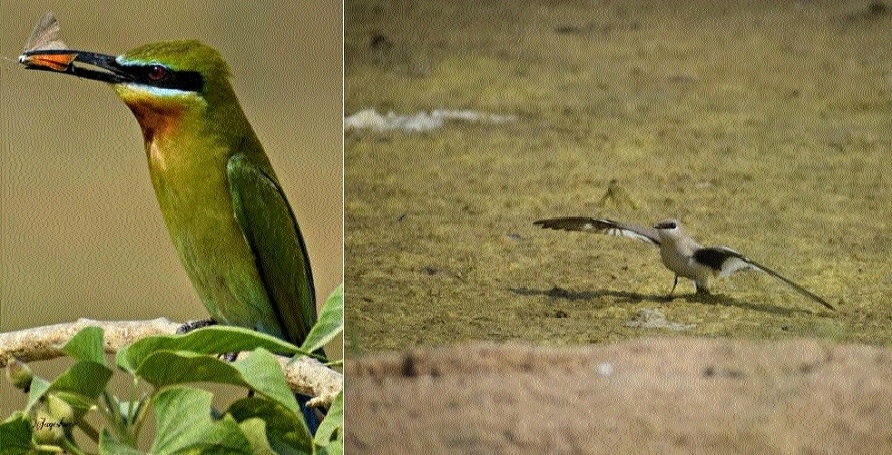Mahanadi proves a big potential site for study on summer nesting
| Date :18-Jan-2021 |

Blue-tailed Bee-eater Small Pratincole
By Roshan Chachane :
RAIPUR,
A group of researchers set out to study summer nesting avian species along Mahanadi have revealed some interesting nesting birds which previously went unnoticed and undocumented. The study led by noted Ornithologist AMK Bharos along with Jageshwar Verma, Faiz Bux and ornithologist Ravi Naidu throughout a 130-kilometre stretch of Mahanadi has revealed the nesting behaviour of two avian species as Blue-tailed Bee-eater and Small Pratincole during the summer, which was never reported from State. The State of Chhattisgarh can be divided into three regions as Surguja Division in the North, Raipur Division in the Centre and Bastar Division in the South.
The northern has Hasdeo river Basin, Central region has Mahanadi Basin and Southern region has Indrawati Basin. These rivers are some of the best places to find avian species for the obvious availability of greenery and prey. The Mahanadi River, where the study was undertaken, is the prime river of the state; it originates from Shringery hills near Sihawa town of Dhamtari district, Chhattisgarh. Initially, the river flows southward then turns to the north and en-route to Odisha flows across Dhamtari, Kanker, Gariyaband, Raipur, Mahasamund, Baloda Bazaar, Janjgir-Champa, and Raigarh districts of Chhattisgarh, covering 280 km. At this river several threatened species viz: River Lapwing (Vanellus duvaucelii), Painted Stork (Mycteria leucocephala), Asian Woolly-neck (Ciconia episcopus), Indian Spotted Eagle (Clanga hastate) Spotbilled Pelican (Pelecanus philippensis), Indian Skimmer (Rynchops albicollis), River Tern (Sterna aurantia), Eurasian Curlew (Numenius arquata), Malabar Pied Hornbill (Anthracoceros coronatus) have been documented and significant species viz: Common Mergansar Grey–headed Lapwing, Demoiselle Crane (Grus virgo) also have been recorded earlier.
A segment of river Mahanadi, including Gangrel Dam, and amidst Teela barrage to Samoda barrage and further 40 km downstream at Dhamni village in Balodabazar district, were frequently visited and studied from October 2017 to June 2019. These are mostly open plains, and vegetation comprises small forest patches, plantations, patches of scrub forest, and cultivation. The study sites, Gangrel Dam, Khutamuda, Gangrel Dam Dhamtari District, Teela barrage, Nisda barrage, Samoda barrage, Kutela- Mohmela and Gidhpuri, Dongardevi Temple, all in Raipur district, Dhamni-Rohasi Balodabazar district and Bangoli dam- a distant site in Raipur district. Blue-tailed bee-eater (Merops philippinus) The Blue-tailed Bee-eater (Merops philippinus) is a breeding-visitor from North Pakistan, Himalayas and Gangetic plains to Assam valley, also Central India (Satpura) and most of the subcontinent. Their food consists of insects like dragonflies, wasps and bees, also occasionally butterflies, moth and beetles.
They breed generally from March to June and exclusively nest in a tunnel on a vertical river bank or sandy cliffs usually ca. 2 m deep. It nests in a colony of several pairs together. The Small Pratincole (Glareola lactea) is a resident bird and local migrant, which is distributed all over India, affects large serene streams with sand bars and large wetlands, at times in large flocks. The species breeds from February to April and even up until June. It nests in colonies, often several nests close to one another, which are shallow scraps on exposed sandbanks of rivers. Clutch size of normally two eggs and exceptionally three. The nesting birds fly around the nest and agitatedly dive at any intruder. They have a curious habit of walking singly or several at a time, squatting in front of an intruder with open wings and shuffling as if hatching eggs. When approached, by an intruder, they pretend by dragging one wing or beating it on the sand as if broken and making as if to settle on an egg and repeating the act. The Mahanadi River proved to be a big potential site for study on summer nesting avian species. In the recent past 9 threatened species have been recorded here.